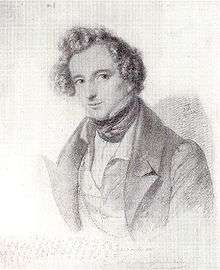Piano Concerto No. 1 (Mendelssohn)
| Piano Concerto in G minor | |
|---|---|
| No. 1 | |
| by Felix Mendelssohn | |
 Drawing of the composer by Eduard Bendemann, 1833 | |
| Key | G minor |
| Catalogue | Op. 25 |
| Composed | 1830–31 |
| Performed | October 1831 |
| Movements | three |
Mendelssohn's Piano Concerto No. 1 in G minor, Op. 25, was written in 1830–31, around the same time as his fourth symphony ("Italian"), and premiered in Munich in October 1831. This concerto was composed during a travel in Italy after the composer met a pianist in Munich.
He had already written a piano concerto in A minor with string accompaniment (1822) and two concertos with two pianos (1823–24).
Structure
The three connected movements use several relatively new formal techniques in their brief span — for example, the piano enters very soon after the opening of the first movement, with little of an orchestral tutti to contrast with.[1] The concerto quickly obtained popularity, and contains many sections of improvisation, one of Mendelssohn's specialities; it is scored for 2 flutes, 2 oboes, 2 clarinets, 2 bassoons, 2 horns, 2 trumpets, timpani and strings.
- Molto allegro con fuoco in G minor
- Andante in E major
- Presto—Molto allegro e vivace in G major
Molto allegro con fuoco
The piano enters after only a few bars of orchestral introduction. It was standard procedure in the classical-era concerto to precede the solo's entrance by a tutti, for various reasons - the length and purpose of these introductions differed, some offering a hint of what was to follow and some giving out almost all the movement's material, but none was so brief as this: in this sense, this was one of the first concertos of the Romantic age. (The obvious exceptions – Mozart's Jeunehomme concerto and Beethoven's fourth and fifth piano concertos – allowed the piano to enter very briefly just at the start, but then proceeded as usual, the soloist silent.) The rest of the movement is fairly typical of concertos in its use of a modified sonata form, with a second, contrasting lyrical theme first heard from the piano over repeated accompaniment, and later on wind. As the movement closes a transition takes the movement not to a full close, but instead, with a brass fanfare and a piano continuation of the same, to the border of the Andante.
Andante
This opens with a melody in the lower strings, in E major, soon taken up by the piano. This is drawn out with breadth, and a middle section in B provides contrast. The original melody, somewhat varied, returns to close the movement.
Presto—Molto allegro e vivace
This opens with a fanfare in A minor (Presto). The piano joins in, at which point the mood lightens, and the closing rondo - Molto allegro e vivace - begins. This is regular in form, and the returns of the refrain are varied. Several themes from the first movement return towards the finale.
References
- ↑ Philip Radcliffe, Mendelssohn, (Oxford University Press: 2000), 100.
External links
- Timeline
- Another timeline
- Notes to a Performance of the Concerto
- Site with MP3s of Mendelssohn works, including the concerto (requires login and password)
- Piano Concerto No.1, Op.25 (Mendelssohn, Felix): Scores at the International Music Score Library Project (IMSLP)